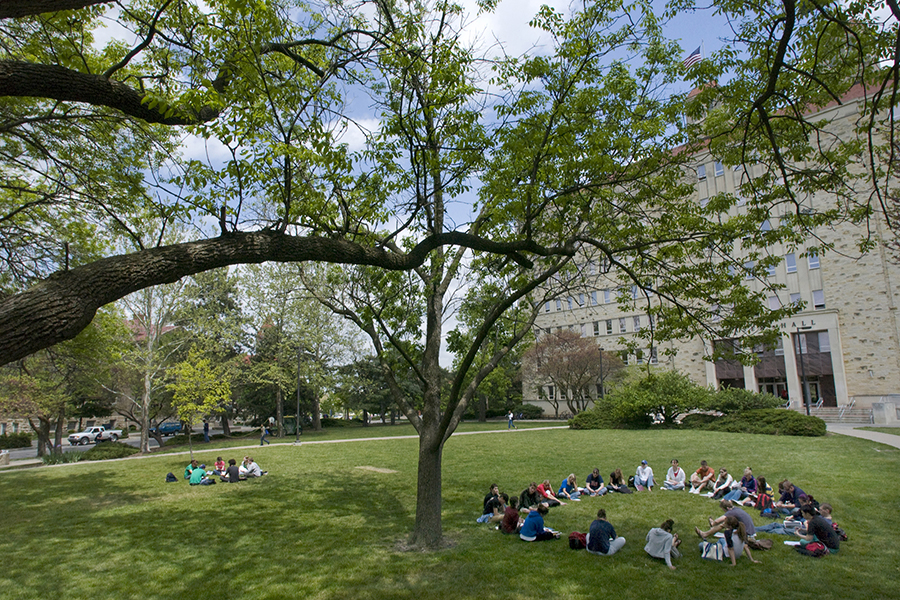Looking Back: An essay by Doug Koch

In the late 1980s, I joined the Office of University Relations as photography coordinator. Like similar offices at other universities, our office had evolved from a news bureau that served both internal and external audiences. Dedicated writers, many with prior experience in the news industry, wrote stories in Associated Press news style. Photographers schooled in photojournalism attempted to walk the line between news and editorial styles. It was generally understood that photographs for The Oread faculty/staff newspaper should not appear glamorous or have high production values. More often than not, engagement with the subject of a story was hurried. On the other hand, editorial and illustrative photos for the Viewbook often required playful direction and stagecraft. Though news and marketing staff had different missions and audiences, they coexisted under the same roof, albeit with some tension and disconnect.
In the early 1990s, the creative staff began to work especially well together on the Viewbook, Explore magazine, and Report, a quarterly tabloid for parents about the student experience. Long, honest discussions about outreach media produced in-house and by peer institutions led us to question assumptions. The director of admissions insisted that the cover of the Viewbook feature a rainbow coalition of students. Extemporaneous capture of diversity was improbable and difficult. The posed photo, a fiction, spoke more about the diverse university we wished to become.

Under the auspices of KU Libraries’ Digital Initiative, Information Technology custom-built an online photo library for our office. New content for the photo web library was vetted by an oversight committee and made publicly accessible.
In the mid-to-late 1990s, coordinators participated in Total Quality Management training, facilitated initially by Human Resources. We systematically questioned the effectiveness of old methods and sought clarity about mission, goals, and roles. Though I was quite aware of the effects of conflicted missions, TQM provided a framework for seeing it from 10,000 feet. Evidence strongly suggested that the photo department’s core mission was often undermined by the need to be partially income-funded. Still, old habits die hard. It would take 20 years for our office to abandon chargeback jobs.
Gradually, the director found more funds for procuring and repairing professional-grade equipment. Photographers’ uncompensated use of personal equipment became unnecessary.

In 2001, our office entered the world of digital capture with a $5,000 Nikon DSLR camera body. Though the image quality of this expensive camera was inferior to that of film, the demand for instantaneous results often overruled objections. Since funding was not available to replace all analog camera bodies with costlier digital bodies, we continued to use film along with digital, with wildly different workflows and timelines, until 2004.
Around this time, we learned that changes at IT made continued support for our online photo library impossible.
In the late 2000s and early 2010s, the proliferation of inexpensive digital capture devices led to a rise in the popularity of photography. At the same time, improvements in camera technology made photos by enthusiasts look more professional. The polished look and high craft of guild-certified photographers fell largely out of favor. A new aesthetic evolved democratically with a billion or so new amateur practitioners. Older photographers who understood this change were wise to adopt a more casual looking approach. Meanwhile, the visual sophistication of an average eight-year old had probably eclipsed that of a 30-something artist from a few earlier decades.

In recent years, great leadership and support have contributed to a creative climate in which superlative photography and videography have flourished. Individual enterprise, teamwork and renewed appreciation for the process of discovery are clearly in play. We routinely discuss the merits of following a class project over time. Outcomes are less preconceived and feel more authentic and sometimes surprising. Permission to investigate hunches and topics of personal interest, once the hallmark of great news enterprises, is common.
A well-tended garden bears much fruit, though no inventory of soil and sun can fully account for this mystery. Likewise, the conditions for inspiration can never exactly foretell its arrival. Yet, its advent is recognized by all.
What a privilege it’s been!
Doug Koch
December 2018